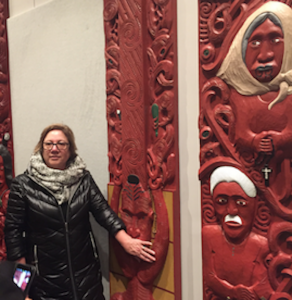Recently Te Wānanga o Raukawa opened a building called Te Ara a Tāwhaki. It marks the journey of an ancestor, Tāwhaki, to the heavens to collect the ‘Kete Uruuru’ or ‘Kete o te Wānanga’, the Baskets of Learning to assist humankind.
In this magnificent building is a central Lecture Theatre called ‘Te Kete Uruuru Rangi’. It is surrounded by carvings. They represent the story of the beginning of the World and the processes of our life journey by learning, despite the ‘dark’ to enable us to live healthily in the ‘light’.
As part of those carvings there are sets of ‘pou’ (carved wall features or poles) which express the ancestoral links each hapū, or tribal group, has. One of these sets speak of the early men and women of Ngāti Kapu, the hapū which has a covenant agreement with the Catholic Archdiocese of Wellington to care for (be ‘kaitiaki’) of the land embracing the Pukekaraka area of the Marae o Hine Nui o te Ao Katoa and St Mary’s at Ōtaki.
In the picture you can see Debbie McAsey, née Taratoa, who is the grand-daughter of one of the people in the carving, Meremaihi. Like her ‘tūpuna’, Debbie is a nurse who cares for the local people and the local marae.
Meremaihi holds a ‘patu’ (greenstone adze) representing the strength of person she was. Meremaihi, known affectionately as ‘Aunty Pepe’, was a force to be reckoned with! She balanced care and generosity with strength and fearlessness. She portrays the strength of the women of her clan; she fought for the rights of her people and literally stood firm on the Tainui pā land through thick and thin. She helped deliver babies on site. Meremaihi sorted out the local men in matters of language and tikanga (process). She is a story (‘pūrākau’) in herself.
One amusing story about Meremaihi notes that she had huge older glasses, like the base of the old glass milkbottles. Her sight was still poor. One day several nuns in their black were strolling on the road near Meremaihi’s home. She called out to the children ‘Get those wandering animals off the road’!
The man in the carving at the bottom (Debbie has her hand on him) is Meremaihi’s father, Arekatera Te Rawaraki. He was a master of assembling and fitting masts on sailing sea-ships. He is holding with both hands above his head a long rafter pole, called a ‘tāhuhu’. He was called on to assist in the building of Rangiatea Church and setting the rafter pole in place. Note that he is holding Rosary Beads in his hands. When the Catholics of Ngāti Kapu helped their relations build Rangiatea Church (Anglican or Mihinare), they left Rosary Beads in the rafters and behind the tukutuku, symbolising their unity in faith and family.
Another person in the right hand carving is holding Rosary Beads. They, like the ones Te Rawaraki holds, mark out the Catholic Faith which to this day is a central focus and strength of the iwi. They mark with pride the relationship Ngāti Kapu has with Rome. Various ‘taonga’ were exchanged with the Pope. To this day the Papal flag flies over Pukekaraka. The beads Te Rawaraki holds are real beads blessed by Cardinal John Dew and given to the carvers by Oriwia Raureti.
The lady with the white shawl is Kui Taruru, who helped bring up the late Makuini Johnson, both proven stalwarts and guides of Faith. Kui Taruru was one of those kuia, elder ladies, who accompanied the early missionaries on their journeys. The Rosary she holds is carved.
Below Kui Taruru is Tira Putu. He was an orator for the people. He is carrying a ‘tokotoko’ or ‘talking stick’ which represents his skill in language. He taught the late Pā Hemi Durning SM te reo Māori. Pā Hemi is one of the priests and sisters buried on Pukekaraka.
These carvings were done by local carvers, Chris Gerretzen, Brian Climie and Bill Doyle. They combine a traditional style of carving (especially in the left-hand pou) and a more modern ‘human relief’ style.
Mā te rarangi whakahī o ēnei tūpuna, tō tātou mana, tō tātou mauriora me tō tātou whakapono e pūmau.
May our mana, our well-being and our faith be held firm as we recognise the proud link we have with our ancestors.
Notes:
-photo used with permission
-recognition of Oriwia Raureti, Debbie McAsey, Huia Winiata and the carvers.
Additional reading
News category: Unlisted resources.




